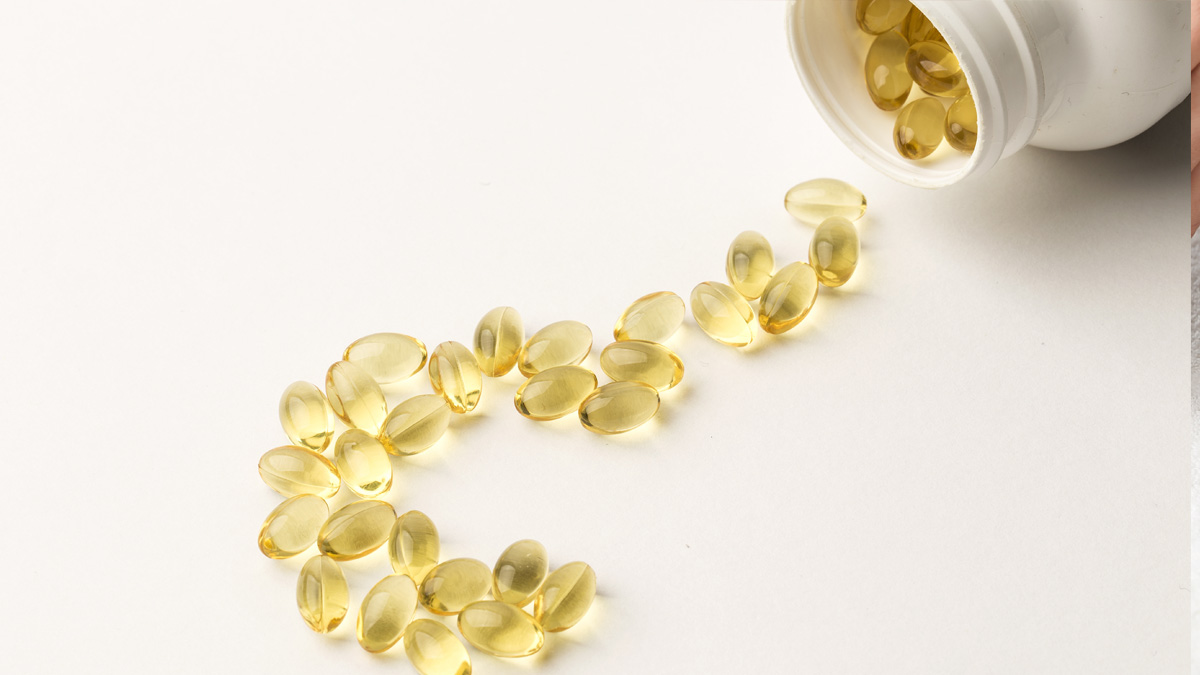
There are two forms of vitamin D in the body – D2 and D3: their empirical chemical formulae differ by a single carbon atom. We get them from different sources: D2 is found primarily in plant-based foods, while D3 is obtained from animal-origin foods, and is also produced when our skin is exposed to the sun’s rays.
What are vitamin D3’s characteristics?
Vitamin D3, or cholecalciferol, is synthesised from a sterol (complex lipid) called 7-dehydrocholesterol, naturally present in the body. When this sterol is exposed to the sun’s UVB rays, it is converted into vitamin D. Most of the vitamin D circulating in the body is produced in this way (1). That’s why we’re advised to expose our skin as much as possible to natural light. Vitamin D3 is also obtained from the diet, in particular from oily fish and egg yolk.
What are vitamin D2’s characteristics?
Vitamin D2, or ergocalciferol, is a derivative of ergosterol, a sterol naturally present in the cell membranes of certain plants and fungi. Vitamin D2 is obtained by exposing ergosterol to the sun’s UVB rays. It is found in mushrooms (especially those exposed to UVB rays) as well as in vitamin D-fortified foods like margarine.
Which form of vitamin D should I choose?
Vitamins D2 and D3 are both metabolised in the liver into calcifediol and then converted in the kidneys into calcitriol, the active and usable form of vitamin D (2). However, research has shown that vitamin D3 increases the level of calcitriol in the body to a greater degree (3). It is also less sensitive to heat and humidity than D2 and thus more stable (4).
As a consequence, if you wish to take a vitamin D supplement, vitamin D3 is the better choice. You have three options to choose from:
- Vitamin D3 5000 IU, with its high 5000 IU dose, is aimed more at those with a known deficiency or higher risk.
- Vitamin D3 Spray, a more convenient form, is recommended for those with a sensitive stomach.
- Vitamin D3 1000 IU, with its 1000 IU dose, is suitable for everyone.
References
- Thomas Ernandez, Catherine Stoermann-Chopard : Vitamine D et insuffisance rénale chronique : regain d’intérêt pour une vitamine oubliée. Rev Med Suisse. 2012, Vol. 8, pp 2140-2145.
- Laura Tripkovic, Helen Lambert, Kathryn Hart, Colin P Smith, Giselda Bucca, Simon Penson, Gemma Chope, Elina Hyppönen, Jacqueline Berry, Reinhold Vieth, and Susan Lanham-New : Comparison of vitamin D2 and vitamin D3 supplementation in raising serum 25-hydroxyvitamin D status: a systematic review and meta-analysis. Am J Clin Nutr. 2012, Vol. 95(6), pp 1357–1364.
- Glendenning P, Chew GT, Inderjeeth CA, Taranto M, Fraser WD : Calculated free and bioavailable vitamin D metabolite concentrations in vitamin D-deficient hip fracture patients after supplementation with cholecalciferol and ergocalciferol. Bone. 2013, Vol. 56(2), pp 271-5.
- Lisa A Houghton, Reinhold Vieth : The case against ergocalciferol (vitamin D2) as a vitamin supplement. Am J Clin Nutr. 2006, Vol. 84(4), pp 694–697.
4 Days
Very happy with the order and the…
Very happy with the order and the prompt team's response to an identified issue with my order.
KUQI Fatmir
11 Days
15 + years as a customer
I have been using their products for over 15 years as I find both the quality and pricing excellent.
Del Chandler
13 Days
Good quick delivery
Good quick delivery
Timothy O Shea
14 Days
Good service
Good communication following order. Product came within the time frame and was well packaged. The only confusing thing I found was in checking out. For some reason it is not clear how to do so and the current system should be improved.
Joe O Leary
23 Days
Simple and fast.
Simple and fast.
Nina
23 Days
Great product was definitely what is…
Great product was definitely what is says and arrived on without issue
customer
29 Days
I love reading those product facts on…
I love reading those product facts on Supersmart.com. Effective health products making permanent changes to my blood-work results and testes. However, I also have to order capsules from other websites.
NORDGULEN Olav
32 Days
Great products
Great products Very easy to choose, to order… and to get at home
Federica mastrojanni
35 Days
Service rapide et bons produits
Service rapide et bons produits
customer
36 Days
Good products and fast delivery
Good products and fast delivery
Trusted
41 Days
Does what it says on the can
I believe in this product Made to highest standard The ordering process is straightforward Delivery time prompt Excellent product, excellent service Happy customer ❤️
Sheba Kelleher
46 Days
Excellents produits
Excellents produits. Rien à dire si ce n'est qu'ils sont très chèrs.
MJS_France
48 Days
Very good supplement
Very good supplement
Glaveash
49 Days
Supersmart supplements are really…effective
Supersmart supplements are really effective and have helped me and family members and friends to improve their health including some of us with severe health problems including some with no existing medical treatment.
Anne Georget
50 Days
SuperBig Supersmart
SuperBig Supersmart
Pierre



